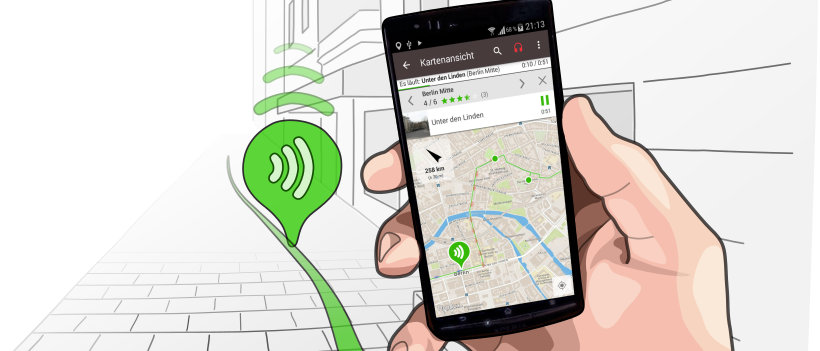Transkript Deutsch:
Du stehst nun also auf dem Bahnhofplatz, das Bahnhofsgebäude befindet sich in deinem Rücken. Wende dich nach links - dort siehst du eine grosse Kirche, die Heiliggeistkirche. Wie viele weitere Kirchen, prägt sie seit dem Mittelalter das Berner Stadtbild und dient seit jeher als Stätte, wo Menschen mit Tod und Trauer umgehen. Auch in anderen Gebetshäusern wie Moscheen oder Tempeln finden Menschen eine Struktur und Rituale, die helfen, sich zu verabschieden.
Wie die meisten solchen Bauten trägt auch die Heiliggeistkirche eine Vielzahl an Zeichen und Symbolen des Lebens und des Lebensendes in sich. Etwa die Sandstein-Urnen, die wie grosse Vasen auf der Ballustrade, dieser Geländer-artigen Dekoration oberhalb der Fassade, stehen. Ein typisch barockes Bauelement, das die Menschen daran erinnern sollte, dass sie sterblich sind. Du begegnest diesen Urnen immer wieder in Bern, beispielsweise auch auf dem Dach des Burgerspitals auf der gegenüberliegenden Strassenseite.
Aber zurück zur Kirche - Nähere dich dem Gebäude und geh zur linken Hausecke.
Als ich vor ein paar Monaten hier vorbei ging, lagen hier, zwischen der Sitzbank und dem Abfalleimer, Blumen am Boden. Rosen, Tulpen und rosa-farbene Blüten, von denen ich den Namen nicht kenne. Zwischen den Blumen standen angezündete Kerzen. Schwarzweiss ausgedruckte, durch Plastikmäppli geschützte Fotos und handgeschriebene Karten lagen ebenfalls da. Ein gelbes Stoffband ergänzte das Bild. Wer sind die Menschen, die dieses temporäre Denkmal errichteten?, habe ich mich gefragt. Wie haben sie sich gefühlt, als sie vor mir, vor dir, hier standen, und ihre mitgebrachten Gedenkobjekte niedergelegten? Was ging ihnen durch den Kopf, als sie die Karten geschrieben oder die Kerzen angezündet haben?
Geh weiter der Fassade entlang Richtung Loeb, bis zum Seiteneingang der Kirche - die grüne Türe mit den drei Treppentritten davor. Als ich ein andermal hier war, hing ein mit Klebstreifen befestigtes Foto an der Tür. Eine junge Frau mit rotem Haar war darauf abgebildet, die Sonne schien ihr ins Gesicht und sie blickte direkt in die Kamera. Daneben war ein anderes Bild, ein Teich mit sich spiegelnden Bäumen, darunter stand in kritzeliger Handschrift «Rest in Peace». Möglicherweise ist das Bild jetzt nicht mehr da, aber vielleicht siehst du noch die Spuren des Klebstreifens. Oder besser gesagt, der vielen Klebstreifen, die unterschiedliche Bilder, Fotos und Texte für eine bestimmte Zeit an dieser Tür befestigten. Wem würdest du hier Gedenken wollen?
Überquere die Tramspuren und gehe zum Loebegge, wo die Glasüberdachung endet. Dort befindet sich die nächste Station.
Transcript English:
You are now standing on the station square, with the station building behind you. Turn left - there you will see a large church, the Heiliggeistkirche. Like many other churches, it has characterised the Bernese cityscape since the Middle Ages and has always served as a place where people deal with death and mourning. Other places of worship, such as mosques or temples, also provide people with a structure and rituals that help them to say goodbye.
Like most such buildings, the Heiliggeistkirche also contains a multitude of signs and symbols of life and the end of life. For example, the sandstone urns that stand like large vases on the balustrade, the railing-like decoration above the façade. A typical baroque architectural element that reminds people that they are mortal. You come across these urns again and again in Bern, for example on the roof of the Burgerspital on the opposite side of the street.
But back to the church - approach the building and go to the left-hand corner.
When I walked past here a few months ago, there were flowers on the ground between the bench and the rubbish bin. Roses, tulips and pink-coloured flowers that I don’t know the name of. There were lit candles between the flowers. There were also black and white printed photos protected by plastic folders and handwritten cards. A yellow fabric ribbon completed the picture. Who are the people who erected this temporary memorial, I asked myself. How did they feel when they stood here in front of me, in front of you, and laid down the memorial objects they had brought with them? What was going through their minds as they wrote the cards or lit the candles?
Keep walking along the façade towards Loeb until you reach the side entrance to the church - the green door with the three steps in front of it. When I was here another time, there was a photo taped to the door. It was of a young woman with red hair, the sun was shining on her face and she was looking straight into the camera. Next to it was another picture, a pond with reflecting trees, with “Rest in Peace” scribbled underneath. The picture may no longer be there, but perhaps you can still see the traces of the sticky tape. Or rather, the many adhesive strips that attached various pictures, photos and texts to this door for a certain period of time. Who would you want to commemorate here?
Cross the tram tracks and walk to Loebegge, where the glass roof ends. The next stop is there.



